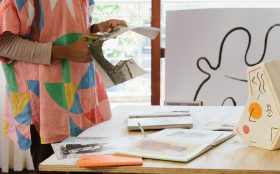Image via Shutterstock
If you have ever suffered from a creative block chances are you’ve Googled for something to pull you out of the slump. Inspirational quotes are easy to find, and generally run along the lines of ‘sit down and do the work, and you will work yourself out of the block’. This is great advice, but what happens when ‘sit down and do the work’ is just not enough?
In 2017 I embarked on a personal creative challenge to write a song a day for 365 days. I called it The Song-Chain Project, and it was a huge undertaking that I found both supremely rewarding and extraordinarily difficult. In the end I fell short of my 365 song goal, but I did produce 180 songs, soundscapes, free improvisations, musical poems, nonsense, noise and other pieces of musical art, a body of work that I am incredibly proud of.
The project was my own way of sitting down and doing the work, and it really worked, until it didn’t. I wrote this in my blog on March 29:
‘This project was never meant to be easy, although up to now it has never felt impossible, and I’ve generally kept to my deadlines and retained my confidence in my ability to churn out new music when required. Over the weekend, however, I fell apart and spent a large part of it paralysed by anxiety. My rational brain knew that if I could just sit down and do the work I would end up with something, but when I tried I was unable to concentrate and found the anxiety expressing itself in physical symptoms, which is something I haven’t really experienced before.’
This was quite early in the project, and forced me to start examining the things that negatively impacted my creativity. The two that kept coming back were a tendency toward perfectionism, and my tangled relationship between myself as an artist and myself as a person.
Perfection vs excellence
At a very timely moment during the project I caught part of a discussion on ABC Radio National on the difference between striving for excellence, which is a positive pursuit, and striving for perfection, which can hinder rather than help your progress. While there are varying definitions of perfectionism, the two aspects that reflected my own experience were a focus on the end product, rather than the journey or process to get there, and judging my self-worth on my ability to achieve my unrealistically high standards. I wrote in that same March 29 blog post:
‘…my focus on producing a piece of music that lived up to my expectations was creating a rigid mindset that was not compatible with the flexibility required to engage with the songwriting process.’
This flexibility was really the key to creativity for me. I did my best work when I was able to remove any expectations of what I should produce that day, letting the process lead wherever it wanted. I developed tools throughout the project to help keep me flexible and focussed on the process rather than the product, and I have included some of these at the end of this article.
Art vs self in a world of likes and analytics
Our digital landscape is shaping the way we work as creatives, in many ways for the better. Digital platforms give us the opportunity to share our work with the world, self-manage our careers and build audiences we would not have had access to in the past. We open a window to our processes and lives, engage in conversations about our work and build our creative networks. Unless we are working under an alter ego we are often sharing just as much of our personal lives as we are our creative work. We all love connecting with the artist behind the work, and many of us will have found our sales, engagement and profile growing as we open up through social media, blogging, podcasting and live streaming.
The difficulty comes as we struggle to separate our self worth from our creative output or perceived success. The digital world reduces our success to a series of numbers – likes, shares and analytics. When a business or brand notices these numbers dropping they can view it objectively, and develop new strategies to push the numbers back up again. For an artist working under their own name it can feel like a personal attack. If your audience is no longer interested in your work they are no longer interested in you. Your work is bad, and you are by extension a bad person.
I shared my work on the Song-Chain Project both on my website and across social media. As I settled into the routine of the project and digital engagement slowed, I found myself questioning whether what I was creating was any good, or if anyone was actually interested in my work. This pushed my focus to the end product, and suddenly I was faced with the impossible task of creating something that would meet the approval of my imaginary critics and keep up with the perceived success of my peers. The only way out of this was to simply create for myself, to enjoy the process, and to find things I was proud of about my work, regardless of what anyone else thought.
Tools for working through your blocks
Below are a few tools I found particularly helpful throughout The Song-Chain Project:
- Use a timer
I used a timer almost every day of the project, and it was my number one procrastination-buster. I often followed the traditional 20 minute blocks recommended by the Pomodoro Technique, but I also used much shorter blocks for small writing exercises. Using a timer kept my focus squarely on the process, and made me far more productive than on days when I didn’t use it.
- Work within creative restrictions
Rather than limiting creativity, I found that restrictions helped it flourish. Your restrictions will depend on your medium. Some of mine were working with a limited set of notes, writing on an instrument I was unfamiliar with, or using numbers to generate material for composition. Your restrictions might be exploring one colour, working only with dots, starting every sentence using a word beginning with G, or working with a medium or tool you’ve never used before.
- Find a starting point
Sometimes starting is the hardest part. For the Song-Chain Project I took something from the previous day’s song as the starting point for the next song, hence the song-chain. Your starting point can be anything – a colour, a random word from a book, a newspaper headline, an idea stolen from another piece of artwork or music. More often than not your work will end up miles away from this starting point when you’re done, which is fine, as its purpose is solely to facilitate creative work.
- Reassess your markers of success
Instead of focussing your idea of success on likes, engagement, analytics, competition and grant wins or comparisons with your peers, shift this focus to your own personal artistic development. Success can be learning a new technique, getting 20 minutes of uninterrupted work done, sending off three emails that might lead to future opportunities, or making something entirely for yourself and not showing anyone else.
- Embrace email marketing
With social media marketing we are at the mercy of changing algorithms, and have limited control over our success on these platforms. A drop in engagement can be a blow to your artistic confidence, and impact your ability to sell your work and communicate with your audience. The old fashioned email list is the one promotional tool you have complete control over, so you should cultivate it and use it regularly and mindfully. There are lots of opportunities for collecting email addresses, from sign-up sheets at exhibitions, gigs and live events, to forms on your website. If you have physical products you can also run a giveaway in exchange for email addresses.
- Get regular digital downtime
Our constant connection is not only distracting, but it can fuel all the negative thoughts that creep in to hinder your creativity. One of the most useful tools I found was an Android app called Offtime. It can restrict your access to certain apps, block notifications and send calls straight to voicemail for a specified period of time. I use it when I want to work undistracted, but also to restrict my social media access to a small part of the day, which has had a hugely positive impact on my mood and productivity.
I hope that these tools find their way into your own creative toolbox, adapted to suit your own working style and creative medium. The one final thing I would add is to be kind to yourself. Creative work is full of challenges, and we can be really hard on ourselves when we’re not as productive or successful as we would like to be. While sitting down and doing the work is often the answer, sometimes we also need to take time to examine what else is getting in our way. The Song-Chain Project taught me so much about myself, and I am looking with anticipation to my next creative project, and to continuing my own personal and professional creative development.
Follow the author on Instagram, Facebook and Twitter and learn more about The Song-Chain Project at ericabramham.com.





